Johannes Vermeer
From Wikipedia, the free encyclopedia
"Vermeer" redirects here. For other uses, see Vermeer (disambiguation).
| Johannes Vermeer | |
|---|---|
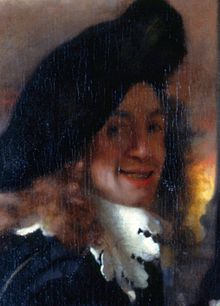
|
|
| Born | Baptized 31 October 1632 Delft, Dutch Republic |
| Died | 15 December 1675 (aged 43) Delft, Dutch Republic |
| Nationality | Dutch |
| Education | Carel Fabritius? |
| Known for | Painting |
| Notable work(s) | 34 works have been universally attributed to him[2] |
| Movement | Dutch Golden Age Baroque |

Delft in 1652, by cartographer Willem Blaeu
Vermeer worked slowly and with great care, using bright colours and sometimes expensive pigments, with a preference for lapis lazuli and Indian yellow. He is particularly renowned for his masterly treatment and use of light in his work.[4]
Vermeer painted mostly domestic interior scenes. "Almost all his paintings are apparently set in two smallish rooms in his house in Delft; they show the same furniture and decorations in various arrangements and they often portray the same people, mostly women."[5]
Recognized during his lifetime in Delft and The Hague, his modest celebrity gave way to obscurity after his death; he was barely mentioned in Arnold Houbraken's major source book on 17th-century Dutch painting (Grand Theatre of Dutch Painters and Women Artists), and was thus omitted from subsequent surveys of Dutch art for nearly two centuries.[6][7] In the 19th century, Vermeer was rediscovered by Gustav Friedrich Waagen and Théophile Thoré-Bürger, who published an essay attributing sixty-six pictures to him, although only thirty-four paintings are universally attributed to him today.[2] Since that time, Vermeer's reputation has grown, and he is now acknowledged as one of the greatest painters of the Dutch Golden Age.
Contents
Life

A row of houses on the market in Delft, with the inn Mechelen, but made circa 1730 by Leonard Schenk after a drawing by Abraham Rademaker
Youth
On 31 October 1632, Johannes was baptized in the Reformed Church.[10][11][Note 1] His father, Reijnier Janszoon, was a middle-class worker of silk or caffa (a mixture of silk and cotton or wool).[Note 2] As an apprentice in Amsterdam, Reijnier lived on fashionable Sint Antoniesbreestraat, then a street with many resident painters. In 1615, he married Digna Baltus. The couple moved to Delft and had a daughter, Geertruy, who was baptized in 1620.[Note 3] In 1625, Reijnier was involved in a fight with a soldier named Willem van Bylandt, who died from his wounds five months later.[12] Around this time, Reijnier began dealing in paintings. In 1631, he leased an inn called "The Flying Fox". In 1641, he bought a larger inn on the market square, named after the Flemish town "Mechelen". The acquisition of the inn constituted a considerable financial burden.[Huerta 1] When Vermeer's father died in October 1652, Vermeer assumed operation of the family's art business.Marriage and family
Career
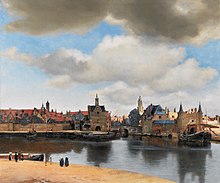
View of Delft (1660–61) "He took a turbulent reality, and made it look like Heaven on earth."[15]
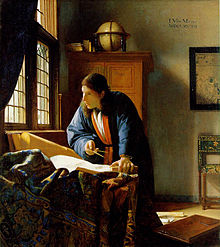
The Geographer by Johannes Vermeer.
On 29 December 1653, Vermeer became a member of the Guild of Saint Luke, a trade association for painters. The guild's records make clear that Vermeer did not pay the usual admission fee. It was a year of plague, war and economic crisis; Vermeer was not alone in experiencing difficult financial circumstances. In 1654, the city suffered the terrible explosion known as the Delft Thunderclap, which destroyed a large section of the city.[17] In 1657, he might have found a patron in the local art collector Pieter van Ruijven, who lent him some money. In 1662, Vermeer was elected head of the guild and was reelected in 1663, 1670, and 1671, evidence that he (like Bramer) was considered an established craftsman among his peers. Vermeer worked slowly, probably producing three paintings a year, and on order. When Balthasar de Monconys visited him in 1663 to see some of his work, Vermeer had no paintings to show. The diplomat and the two French clergymen who accompanied him were sent to Hendrick van Buyten, a baker, who had a couple of his paintings as collateral.
In 1671, Gerrit van Uylenburgh organised the auction of Gerrit Reynst's collection and offered thirteen paintings and some sculptures to Frederick William, Elector of Brandenburg. Frederick accused them of being counterfeits and had sent twelve back on the advice of Hendrick Fromantiou.[18] Van Uylenburg then organized a counter-assessment, asking a total of 35 painters to pronounce on their authenticity, including Jan Lievens, Melchior de Hondecoeter, Gerbrand van den Eeckhout and Johannes Vermeer.
In 1672, a severe economic downturn (the "Year of Disaster") struck the Netherlands, after Louis XIV and a French army invaded the Dutch Republic from the south (known as the Franco-Dutch War). During the Third Anglo-Dutch War, an English fleet and two allied German bishops attacked the country from the east, causing more destruction. Many people panicked; courts, theaters, shops and schools were closed. Five years passed before circumstances improved. In 1674 Vermeer was listed as a member of the civic guards.[19] In the summer of 1675, Vermeer borrowed 1,000 guilders in Amsterdam, using his mother-in-law's property as a surety.[20][21] In December 1675, Vermeer died after a short illness. In a petition to her creditors his wife later described his death as follows:
...during the ruinous war with France he not only was unable to sell any of his art but also, to his great detriment, was left sitting with the paintings of other masters that he was dealing in. As a result and owing to the great burden of his children having no means of his own, he lapsed into such decay and decadence, which he had so taken to heart that, as if he had fallen into a frenzy, in a day and a half he went from being healthy to being dead.[22]He was buried in the Protestant Old Church on 15 December 1675.[Note 9][Note 10] Catharina Bolnes attributed her husband's death to the stress of financial pressures. The collapse of the art market damaged Vermeer's business as both a painter and an art dealer. She, having to raise 11 children, asked the High Court to relieve her of debts owed to Vermeer's creditors.[Montias 1] The Dutch microscopist Antonie van Leeuwenhoek, who worked for the city council as a surveyor, was appointed trustee. The house, with eight rooms on the first floor, was filled with paintings, drawings, clothes, chairs, and beds. In his atelier, there were two chairs, two painter's easels, three palettes, ten canvases, a desk, an oak pull table, a small wooden cupboard with drawers and "rummage not worthy being itemized".[Montias 4] Nineteen of Vermeer's paintings were bequeathed to Catharina and her mother. The widow sold two more paintings to Hendrick van Buyten in order to pay off a substantial debt.[23]
Vermeer had been a respected artist in Delft, but almost unknown outside his home town. The fact that a local patron, Pieter van Ruijven, purchased much of his output reduced the possibility of his fame spreading.[Note 11] Several factors contributed to his limited oeuvre. Vermeer never had any pupils and therefore there was no school of Vermeer. His family obligations with so many children may have taken up much of his time, as would acting as both an art-dealer and inn-keeper in running the family businesses. His time spent serving as head of the guild and his extraordinary precision as a painter may have also limited his output.
Style

Lady Seated at a Virginal (c. 1672)

The Milkmaid (c. 1658)
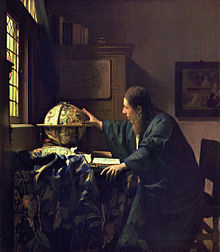
The Astronomer (c. 1668)

The Girl with the Wine Glass (c. 1659)
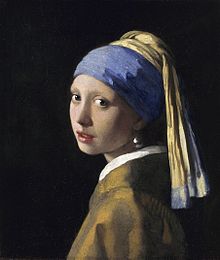
Girl with a Pearl Earring (1665), considered a Vermeer masterpiece

The Music Lesson or A Lady at the Virginals with a Gentleman, c. 1662–65; Vermeer
There is no other seventeenth-century artist who early in his career employed, in the most lavish way, the exorbitantly expensive pigment lapis lazuli, or natural ultramarine. Vermeer not only used this in elements that are naturally of this colour; the earth colours umber and ochre should be understood as warm light within a painting's strongly-lit interior, which reflects its multiple colours onto the wall. In this way, he created a world more perfect than any he had witnessed.[Liedtke 3] This working method most probably was inspired by Vermeer’s understanding of Leonardo’s observations that the surface of every object partakes of the colour of the adjacent object.[24] This means that no object is ever seen entirely in its natural colour.
A comparable but even more remarkable, yet effectual, use of natural ultramarine is in The Girl with a Wineglass. The shadows of the red satin dress are underpainted in natural ultramarine,[25] and, owing to this underlying blue paint layer, the red lake and vermilion mixture applied over it acquires a slightly purple, cool and crisp appearance that is most powerful.
Even after Vermeer’s supposed financial breakdown following the so-called rampjaar (year of disaster) in 1672, he continued to employ natural ultramarine generously, such as in Lady Seated at a Virginal. This could suggest that Vermeer was supplied with materials by a collector, and would coincide with John Michael Montias’ theory that Pieter van Ruijven was Vermeer’s patron.
Vermeer's works are largely genre pieces and portraits, with the exception of two cityscapes and two allegories. His subjects offer a cross-section of seventeenth-century Dutch society, ranging from the portrayal of a simple milkmaid at work, to the luxury and splendour of rich notables and merchantmen in their roomy houses. Besides these subjects, religious, poetical, musical, and scientific comments can also be found in his work.
Theories of mechanical aid
Vermeer's painting techniques have long been a source of debate, given their almost photorealistic attention to detail, despite Vermeer having had no formal training, and despite only limited evidence that Vermeer had created any preparatory sketches or traces for his paintings.In 2001, British artist David Hockney published the book Secret Knowledge: Rediscovering the Lost Techniques of the Old Masters, in which he argued that Vermeer – among other Renaissance artists including Hans Holbein and Diego Velázquez – used optics, and specifically some combination of curved mirrors, camera obscura and camera lucida, to achieve precise positioning in their compositions. This became known as the Hockney–Falco thesis, named after Hockney and Charles M. Falco, another proponent of the theory.
Working independently, in 2001 British architecture professor Philip Steadman published the book Vermeer's Camera: Uncovering the Truth behind the Masterpieces, which specifically claimed that Vermeer had used a camera obscura to create his paintings. Noting that many of Vermeer's paintings had been painted in the same room, Steadman found six of his paintings that are precisely the right size if they had been painted from inside a camera obscura in the room's back wall.[26]
Supporters of these theories have pointed to evidence in some of Vermeer's paintings, such as the often-discussed sparkling pearly highlights in Vermeer's paintings, which they argue are the result of the primitive lens of a camera obscura producing halation. It was also postulated that a camera obscura was the mechanical cause of the "exaggerated" perspective seen in Lady at the Virginals with a Gentleman (London, Royal Collection).
In 2008, American entrepreneur and inventor Tim Jenison developed the theory that Vermeer had used a camera obscura along with a "comparator mirror", which is similar in concept to a camera lucida but much simpler, and allows for easily matching color values. He later modified the theory to simply involve a concave mirror and a comparator mirror. He spent the next five years testing his theory by attempting to re-create The Music Lesson himself using these tools, a process captured in the 2013 documentary film Tim's Vermeer.[27]
Several points were brought out by Jenison in support of this technique: First was Vermeer's hyper-accurate rendition of light falloff along the wall. Another was the addition of several highlights and outlines consistent with matching the effects of chromatic aberration, particularly noticeable in primitive optics. Last, and perhaps most telling, is a noticeable curvature in the original painting's rendition of the scrollwork on the harpsichord. This effect, caused by exactly duplicating the view as seen from a curved mirror, matched Jenison's technique precisely.
This theory remains disputed. Aside from the accurately observed mirror reflection above the lady at the virginals, there is no historical evidence regarding Vermeer's interest in optics. The detailed inventory of the artist's belongings drawn up after his death does not include a camera obscura or any similar device.[28]
Works
Only three paintings are dated: The Procuress (1656; Gemäldegalerie, Dresden); The Astronomer (1668; Musée du Louvre, Paris); and The Geographer (1669; Städelsches Kunstinstitut, Frankfurt).Vermeer's mother-in-law, Maria Thins, owned Dirck van Baburen's 1622 oil-on-canvas Procuress (or a copy of it), which appears in the background of two of Vermeer's paintings. The same subject was also painted by Vermeer. After creating his own The Procuress, almost all of Vermeer's paintings are of contemporary subjects in a smaller format, with a cooler palette dominated by blues, yellows and grays. Practically all of his surviving works belong to this period; usually domestic interiors with one or two figures lit by a window on the left. They are characterized by a serene sense of compositional balance and spatial order, unified by a pearly light. Mundane domestic or recreational activities become thereby imbued with a poetic timelessness (e.g. Girl Reading a Letter at an Open Window, Dresden, Gemäldegalerie). Vermeer's two townscapes, View of Delft (The Hague, Mauritshuis) and A street in Delft (Amsterdam, Rijksmuseum), have also been attributed to this period.
A few of his paintings show a certain hardening of manner and are generally thought to represent his late works. From this period come The Allegory of Faith (c 1670; Metropolitan Museum of Art, New York) and The Love Letter (c 1670; Rijksmuseum, Amsterdam).
Rediscovery and legacy
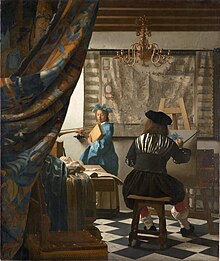
Vermeer's Art of Painting or The Allegory of Painting (c. 1666-68)
Upon the rediscovery of Vermeer's work, several prominent Dutch artists, including Simon Duiker, modelled their style on his work. Other artists who were inspired by Vermeer include the Danish painter Wilhelm Hammershoi[32] and the American Thomas Wilmer Dewing.[33] In the 20th century, Vermeer's admirers included Salvador Dalí, who painted his own version of The Lacemaker and pitted large copies of the original against a rhinoceros in some now-famous surrealist experiments. Dali also immortalized the Dutch Master in The Ghost of Vermeer of Delft Which Can Be Used As a Table, 1934.
Han van Meegeren was a 20th-century Dutch painter who worked in the classical tradition. Motivated by a blend of aesthetic and financial reasons, van Meegeren became a master forger, creating and selling many new 'Vermeers' before being caught and tried.[34]
References in other media
In the first volume of Marcel Proust's novel In Search of Lost Time, entitled Swann's Way, the protagonist Charles Swann is said to be working on an extended essay concerning Vermeer's art. In addition, Vermeer's View of Delft features in a pivotal sequence of a later volume, The Captive, in the same work.A Vermeer painting plays a key part of the dénouement in Agatha Christie's After the Funeral (1953). Susan Vreeland's novel Girl in Hyacinthe Blue follows eight individuals with a relationship to a painting of Vermeer. The young adult novel Chasing Vermeer by Blue Balliett centers around the fictitious theft of Vermeer's A Lady Writing. J.P. Smith's novel, The Discovery of Light, deals largely with Vermeer. The character of Barney, in Thomas Harris's novel Hannibal (1999), has a goal to see every Vermeer painting in the world before he dies.
Tracy Chevalier's novel Girl with a Pearl Earring and the film of the same name (2003) are named after the painting; they present a fictional account of its creation by Vermeer and his relationship with the (equally fictional) model. The film was nominated for Oscars in cinematography, art direction, and costume design.
Peter Greenaway's film A Zed & Two Noughts (1985) contains a plot line about an orthopedic surgeon named Van Meegeren who stages highly exact scenes from Vermeer paintings in order to paint copies of them.
John Jost's film All the Vermeers in New York (1990) makes reference to a woman's resemblance to a Vermeer painting.
The Dutch composer Louis Andriessen based his opera Writing to Vermeer (1997–98, libretto by Peter Greenaway) on the domestic life of Vermeer.
The song "No One Was Like Vermeer" from the 2008 album Because Her Beauty Is Raw and Wild by Boston singer-songwriter Jonathan Richman pays tribute to Vermeer's painstaking technique. Richman also references Vermeer in his song "Vincent Van Gogh" and both songs are frequently part of Richman's live performances.
"Jan Vermeer" is a rockabilly song written by Bob Walkenhorst for his solo album The Beginner. David Olney's song "Mister Vermeer" on his 2010 album Dutchman's Curve imagines Vermeer's unrequited love for the subject of Girl with a Pearl Earring.
Historian Timothy Brook's Vermeer's Hat: The Seventeenth Century and the Dawn of the Global World (2007) examines six of Vermeer's paintings for evidence of world trade and globalization during the Dutch Golden Age.
The 2013 documentary film Tim's Vermeer follows inventor Tim Jenison's examination on his theory that Vermeer used optical devices to assist in generating his realistic images.[35]



No comments:
Post a Comment
Please leave a comment-- or suggestions, particularly of topics and places you'd like to see covered